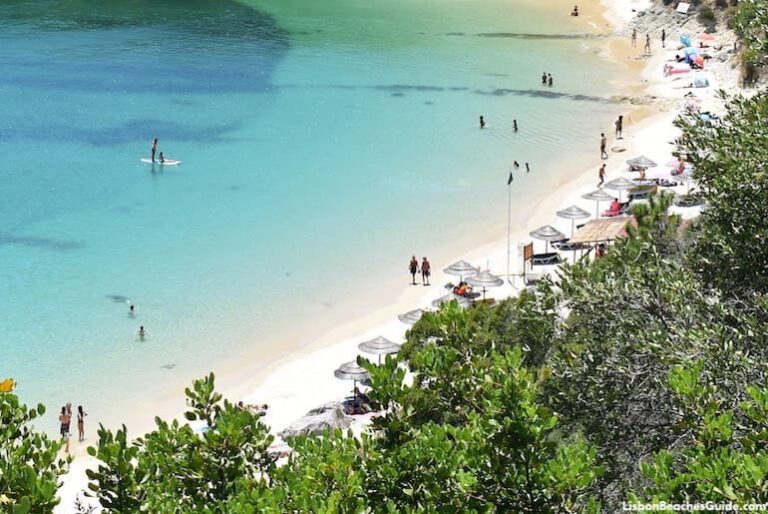Blog
Top 11 Most Beautiful Beaches In Portugal
You can look forward to sandy islands lapped by cerulean seas, peaceful coves tucked near edge-of-the-earth sea cliffs and dune-backed expanses facing some of the world’s most dramatic surfing spots. The challenge is deciding where to begin.
Although a list of the country’s best beaches could easily run into triple digits, here are our picks for the top 11 beaches in Portugal.
Seek out a hidden slice of paradise at Praia dos Galapinhos

Less than an hour’s drive from Lisbon, you can find yourself amid the coastal wilderness of the Parque Natural da Arrábida. Here, forest-covered hillsides descend steeply to the shoreline, which is dotted with hidden coves and sparkling beaches. The loveliest of the bunch is the Praia dos Galapinhos, which offers white sand and crystal-clear waters. The calm seas make it a great swimming spot.
Relax with the family or ride the waves off 
Amid the wilder shores of the western Algarve, Praia de Odeceixe hits all the right notes, and the scenic headland-backed beach draws both families and surfers. Its unique location provides for surprising versatility. Lying at the mouth of the Rio Odeceixe, the beach has a sandy riverside section that’s perfect for splashing about without worrying about the pounding surf.
If it’s waves you seek, you’ll find them by strolling over to the ocean, where rideable breaks arrive year-round (though conditions are best in winter). Various surf academies – including Odeceixe Surf School – can help you hone your skills, or teach you some new ones.
Go surfing or just sit at a beachfront cafe at Praia Baleal
About 5km (3 miles) northeast of Peniche on Portugal’s west coast, Praia Baleal is a real showstopper of a beach. This stretch of sand is actually a causeway, linking the mainland to the scenic, island-like village of Baleal, which stands atop a craggy headland jutting from the Atlantic Ocean. The fantastic sweep of sandy beach here offers swimming both to the north and south, as well as some fine surfing. Surf schools and several bar-restaurants are located along the beach.
Swim under the red cliffs of Praia da Falésia
The Algarve has more than its fair share of breathtaking beaches, and this 6km-long (3.75 miles) strip of sand backed by stunning ochre-hued cliffs has to be one of its most impressive. Starting 8.5km (5.25 miles) east of Albufeira, this strand gets very crowded in summer, especially when the tide is in. But in low season, it will be all yours.
The trek to Praia de São Jacinto is worth the effort
Sandwiched between crashing Atlantic breakers and endless sand dunes, this magnificent beach forms the western flank of the São Jacinto nature reserve. The beach requires a 20-minute bus journey (from Aveiro to Forte da Barra), a ferry (to São Jacinto), and a brisk walk to reach – and the toil will be worth every second for those who like their beaches sandy, remote and rugged. As an added bonus, Aveiro is only 50 minutes from Porto by train, making this beach a great day trip from the city.
Praia do Cabedelo is the best of Viana do Castelo’s many beaches
Near the country’s northern border with Spain, Viana do Castelo is blessed with an appealing medieval center, an attractive riverfront and lovely beaches just outside the city. The pick of the lot is Praia do Cabedelo, a 1km-long (0.6 miles) arc of powdery blond sand that folds into grassy dunes backed by a grove of wind-blown pines. It’s across the river from town, best reached on a five-minute ferry trip from the pier south of the Praça da Liberdade.
Discover an island getaway in the eastern Algarve at Isla de Tavira
This huge beach at the eastern end of Ilha de Tavira – a long barrier island just off the country’s southern coast – boasts golden sands and inviting, clear waters, plus a sprinkling of beach bars, a windsurf school and a campground in summer (the only accommodation on the island). Outside the peak months of July and August, it feels wonderfully remote and empty. Ferries make the 10-minute hop to the island from Quatro Águas, 2km (1.25 miles) southeast of Tavira, one of the Algarve’s most charming towns.
Savor family fun on Praia das Furnas
On the left bank of the Rio Mira on the coast of Portugal’s southern Alentejo region, Praia das Furnas is a long stretch of fine sand backed by small rocky cliffs. The sandbars in the area make for some relaxing frolicking in the waves – a good option for families. You can arrive here by car, or you can take the small ferry from Vila Nova de Milfontes, a low-key resort town with lots of charm.
Descend the steps to tiny, delightful Praia do Camilo
Praia do Camilo is a prime example of the small sandy coves that dot the coastline of the Algarve region. The small, dramatically set beach is located on the outskirts of Lagos, a pretty resort town with cobbled lanes and picturesque squares enclosed by 16th-century walls. Some 200 wooden steps help beachgoers descend to the golden strip of sand that’s lapped by shallow turquoise waters and encased by wind-gnarled cliffs. Arrive early (or visit out of peak season) to secure towel space.
Lounge with lisboêtas on the Costa de Caparica
One of the easiest beach escapes near Lisbon, the Costa da Caparica on the Setúbal Peninsula has a seemingly never-ending beach that attracts sun-worshiping lisboêtas craving all-over tans, surfers keen to ride Atlantic waves and day-tripping families seeking clean sea and soft sand. It hasn’t escaped development, yet a short distance to the south high-rises soon give way to pine forests and mellow beach-shack cafes.
Watch some of the biggest waves on the planet crash ashore near Nazaré
An underwater canyon off the coast of northern Portugal creates ideal conditions for some of the biggest swells on earth. You can watch these monsters roll in at Praia do Norte, a wild beach backed by dunes located a few kilometers north of the seaside town of Nazaré. The Forte de São Miguel Arcanjo has a roof terrace for taking in the oceanic drama, and there’s also a small museum about the big waves and some of the surfers who’ve ridden them – like Sebastian Steudtner, who rode a record-breaking 26.2m (86ft) behemoth back in 2020.

